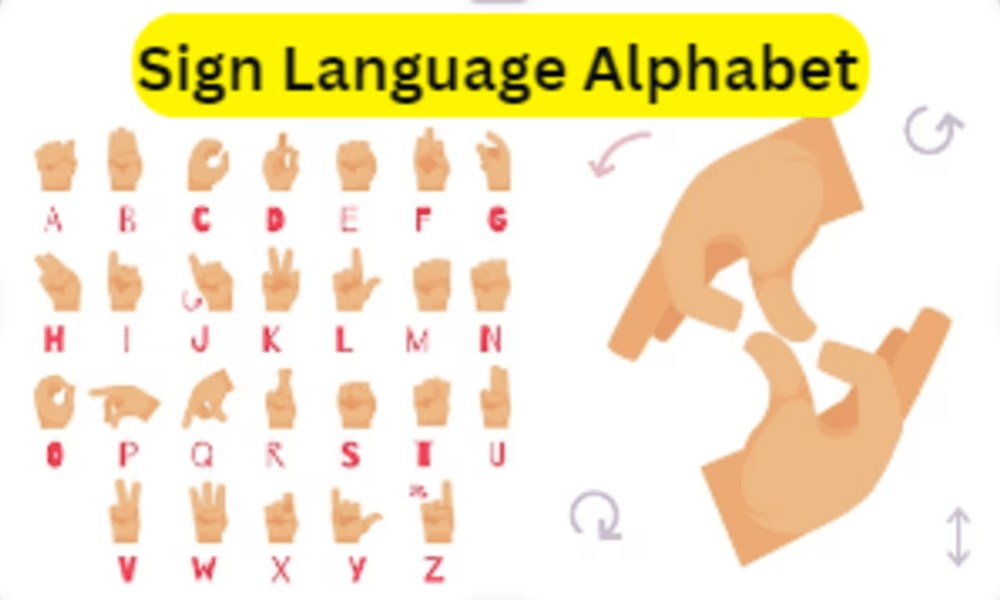Sign Language Alphabet are effective communication is essential in today’s multicultural and inclusive environment. But what happens when we can’t express our ideas and feelings using words? Saving grace is sign language. This article will go into the intriguing world of the Sign Language Alphabet, a potent instrument that helps the deaf and hard of hearing population communicate effectively and tear down barriers.
Understanding Sign Language Alphabet
Let’s first understand the basics of sign language before delving into the Sign Language Alphabet. A visual language, sign language combines hand gestures, facial expressions, and body postures to communicate ideas. It is a full, sophisticated language with its own syntax and grammar.
The Rich History of Sign Language Alphabet
The history of sign language is extensive and rich, going back many centuries. It has changed and adapted to many cultures and geographical areas all over the world. The fact that several countries each have their own sign language with unique vocabulary and grammar is noteworthy. American Sign Language (ASL) is one of the most widely used sign languages in the US.
Sign Language Alphabet
The Building Blocks
The Sign Language Alphabet is the foundation of sign language. In sign language, just like in spoken language; each letter of the alphabet is represented by a distinct set of gestures. These symbols can be used to spell out words, names, and phrases.
The ASL Alphabet
Like many other sign languages, American Sign Language has its own alphabet. Here is how the ASL alphabet looks visually:
| A | B | C | D | E | F | G | H | I | J |
|---|---|---|---|---|---|---|---|---|---|
| 👌 | 🤙 | ✌️ | 👆 | 🖐️ | 👉 | 🤟 | 👋 | 🤙 | 🤞 |
| K | L | M | N | O | P | Q | R | S | T |
|---|---|---|---|---|---|---|---|---|---|
| 👌 | 🤘 | 🖖 | 👌 | 👍 | ✋ | 🤙 | ☝️ | 👋 | ✊ |
| U | V | W | X | Y | Z |
|---|---|---|---|---|---|
| ✊ | ✌️ | 👐 | ❌ | 🤟 | 🤙 |
Each symbol stands for a distinct alphabetic letter. These symbols may be joined in a number of different ways to form words and phrases.
Learning Sign Language
It may be enjoyable to learn sign language, particularly the Sign Language Alphabet. Communication with the hard of hearing and the deaf is made possible, and inclusion and empathy are also encouraged.
Tips for Learning Sign Language
Start with the Basics: Begin with the Sign Language Alphabet to familiarize yourself with the symbols.
Practice Regularly: Like any language, practice makes perfect. Consistent practice will help you become fluent in sign language.
Take Classes: Consider enrolling in sign language classes or finding online resources to guide your learning.
Engage with the Deaf Community: Interaction with native sign language users can greatly enhance your skills.
Be Patient and Respectful: Learning sign language may take time, so be patient with yourself and respectful of the culture.
Sign Language
A Universal Language
Sign language is not limited to any particular region or culture. It is a kind of communication that is not limited to spoken words. Whether you live in South Africa, Japan, or the United States, the Sign Language Alphabet acts as a bridge to unite individuals from various backgrounds.
Sign Language in Everyday Life
Sign language is not just for formal communication. Additionally, it is employed in commonplace contexts like placing a takeaway order, requesting directions, and expressing feelings. Because of its adaptability, sign language is a great resource for those who are deaf or hard of hearing.
Sign Language: An Art Form
Aside from being a means of communication, sign language is also an aesthetic undertaking. Sign language is an expressive and versatile art form that is intriguing and unique.Poetry, storytelling, and performances in sign language are examples of the artistry and beauty of this language.
The Power of Facial Expressions
Facial expressions are an essential component of sign language. They convey emotions, nuances, and tone, adding depth and context to the conversation. Just as spoken language uses intonation and inflection, sign language relies on the subtleties of facial expressions.
The Future of Sign Language
As we adopt new ideas and technologies, sign language keeps developing and modernizing. For the deaf and hard of hearing, mobile apps that permit sign language communication and video relay services have become indispensable tools.
Advocacy and Awareness
In order to ensure inclusion and accessibility for the deaf and hard of hearing population, it is imperative to advocate for sign language rights and raise awareness of its significance. The usage and recognition of sign language are actively being promoted by several organisations and people.
Conclusion
The Sign Language Alphabet is essential for removing obstacles to communication in a society that strives for inclusion and understanding. The lives of the deaf and hard of hearing may be considerably improved by learning sign language, even in its most rudimentary form. It is a language that fosters comprehension, unity, and connection.
FAQs
Is sign language the same worldwide?
No, there are several sign languages for various nations and places. British Sign Language (BSL) and American Sign Language (ASL) are two examples of sign languages.
Can anyone learn sign language?
Yes, anyone can learn sign language. It’s a useful ability that fosters dialogue and inclusion.
How much time does it take to master sign language?
Getting proficient takes different people different amounts of time. Consistent practice and immersion in the language are key factors.
Are there any resources available online to learn sign language?
Yes, there are a ton of internet tutorials, movies, and courses that teach sign language.
Do only those who are hard of hearing and deaf utilize sign language?
Although the deaf population uses sign language primarily, hearing people can also benefit from it through improving communication.
Read More: Techburneh.com










